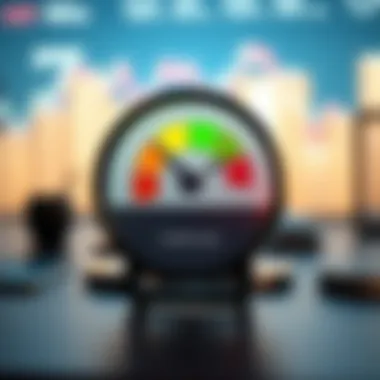Understanding Credit Scores: The Impact of Debt Repayment


Intro
In the intricate world of personal finance, understanding how to manage credit cards can feel like walking a tightrope. Quite often, individuals find themselves baffled by the relationship between debt repayment and credit scores. This phenomenon raises a simple yet profound question: why does paying down credit sometimes trigger unexpected shifts in your creditworthiness? In this exploration, we will unpack the elements at play, from credit utilization ratios to the mechanics of revolving credit accounts. The aim is to provide clarity and arm you with practical insights to navigate your financial journey more effectively.
Understanding Financial Literacy
Definition and Importance
Financial literacy is the ability to understand and effectively use various financial skills, including personal finance management, budgeting, and investing. It’s not merely about being able to balance a checkbook or compute interest rates. The importance of financial literacy lies in its role as a foundational skill that empowers individuals to take control of their financial lives.
When you’re financially literate, you make informed decisions that can help build wealth and security over time. It equates to having the know-how to strategize around loans, savings, and credit - the trifecta of financial health.
Basics of Financial Literacy
Grasping the basics of financial literacy involves familiarizing yourself with several key concepts:
- Credit Scores: Understanding what they are and how they are calculated.
- Debt Management: Knowing how to utilize and pay off debt responsibly.
- Saving Techniques: Learning how to save effectively for both short-term and long-term goals.
- Investment Fundamentals: Getting to grips with basic investment principles.
The acquisition of these skills translates into more resilient financial habits and ultimately leads to a more secure financial future.
Importance of Budgeting
Overview of Budgeting
A budget is akin to a blueprint for your finances. It helps you track your income and expenses, allowing you to see where your money goes each month. This practice is especially crucial for those looking to manage credit effectively.
For young professionals and students flooded with expenses, budgeting serves as a safeguard against overspending. By keeping a close eye on your financial landscape, you can make well-informed decisions about paying down debts, such as credit card balances, while still meeting other financial obligations.
Benefits of Having a Budget
Creating and following a budget offers several advantages:
- Control Over Finances: You determine where every dollar goes.
- Debt Reduction: With a clear plan, you can allocate funds specifically for debt repayment.
- Financial Goals: It becomes easier to save for future plans, whether it’s a holiday or a new vehicle.
- Lower Stress Levels: Fewer financial surprises lead to greater peace of mind.
Applying these budgeting strategies can mean the difference between financial security and confusion, particularly when navigating the complexities of credit management.
"A budget is telling your money where to go instead of wondering where it went."
In the context of understanding credit scores, smart budgeting is imperative. As we delve deeper into credit dynamics, remember that applying the principles of financial literacy and budgeting can place you in a better position for making informed financial decisions.
Learn more about budgeting techniques at the National Endowment for Financial Education.
In the next sections, we will explore the relationship between paying down credit card debt and the underlying mechanisms of credit scoring. By fleshing out these concepts, you’ll become more adept at steering your financial ship smoothly.
Understanding Credit Scores
In today's world, where financial transactions are as common as breathing, understanding credit scores has become indispensable. Not just a number, your credit score acts as a window into your financial health. It's like a report card from lenders that influences whether you'll get that shiny car loan or face higher interest rates. This article dives into the intricacies of credit scores, especially as they relate to paying down credit card debt. By unpacking this concept, we help demystify the influence that these scores hold over your financial life.
Defining Credit Scores
A credit score is essentially a three-digit number ranging from 300 to 850, summarizing your creditworthiness at a glance. Lenders rely on it to gauge how likely you are to repay borrowed money. Think of it as a handshake; the firmer it is, the more trustworthy you seem. It’s often calculated using data from your credit reports, which are detailed summaries of your credit history.
Components of a Credit Score
Understanding the parts that comprise a credit score is crucial. Each component plays a specific role, contributing to the final score that lenders see. These components include:
- Payment History: This is like your reputation. If you've paid bills on time, you're seen as reliable. Missed payments can shake that trust.
- Credit Utilization: This measures how much of your available credit you're using. Keeping this ratio low is key to a healthy score.
- Credit Length: How long your credit accounts have been active matters. A longer credit history generally helps boost your score.
- New Credit: When you apply for credit, it can momentarily ding your score. This component looks at recent inquiries in your credit report.
- Types of Credit: Having a mix of credit—like credit cards, mortgages, and installment loans—demonstrates that you can manage different types of debt.
Payment History
As the biggest slice of the credit score pie, payment history comprises about 35% of your overall score. This means that consistently making payments on time can significantly enhance credibility. However, on the flip side, a single late payment can cause a noticeable dip in your score. The unique feature of payment history is that it is sensitive to recent activity; it is as if it instantly updates your reputation based on your latest actions.
Credit Utilization


The credit utilization ratio, or the amount of credit you use versus what is available, contributes about 30% to your credit score. Keeping this ratio below 30% is often advisable. The key characteristic of this metric is its adaptability since it fluctuates based on your spending habits. Paying down credit cards can help here, but as we will explore later, it doesn’t always translate to an immediate score improvement.
Credit Length
Credit length plays a smaller yet still impactful role, making up approximately 15% of your score. Lenders favor borrowers with longer credit histories, finding comfort in the idea that experience reflects responsible behavior. However, this metric complicates your score if you've recently opened new accounts, as new entries can reduce your average account age.
New Credit
New credit inquiries can account for about 10% of your score. When you apply for loans or credit cards, lenders check your credit, causing a small dip in your score. This aspect is viewed with scrutiny so keeping new credit applications to a minimum is wise. It’s essential to time your applications carefully; too many in a short duration can paint you as desperate, reducing your credibility.
Types of Credit
Finally, having various types of credit accounts can elevate your score, as different credit sources showcase your ability to manage multiple financial commitments. This can account for about 10% of your credit score. However, it isn’t merely about quantity but quality. For instance, diverse credits illustrate reliability, but accumulating too many cards with high balances will backfire.
"A good credit score is like a good friend; you need to invest in it over time for it to be reliable."
Thus, understanding these components allows individuals to fine-tune their strategies for improved credit health. Knowing what influences one's score helps in making informed decisions while managing debt. The paradox of paying down credit often begins with comprehending these key factors.
The Credit Utilization Ratio
When it comes to understanding your credit score dynamics, the credit utilization ratio stands tall. This ratio essentially measures how much of your available credit you are currently using. It’s like a litmus test for lenders, showcasing not just how much you owe but also your credit management habits.
What is Credit Utilization?
Credit utilization is defined as the percentage of your total available credit that you are currently using. To calculate it, you take your total outstanding credit card balances and divide that by your total credit limit across all cards, then multiply by 100 to get a percentage. For example, if you have a total credit limit of $10,000 and your current balance is $3,000, your credit utilization would be 30%. This figure is crucial, as it forms a substantial part of your credit score. Many experts suggest keeping this ratio below 30% for optimal credit health.
Importance of Maintaining a Low Ratio
Maintaining a low credit utilization ratio is vital for several reasons. First and foremost, it showcases to lenders that you are not overly reliant on credit, thereby reducing the risk of default. A low ratio can be a positive signal, suggesting financial responsibility and fiscal savvy. Additionally, it can buffer your credit score against negative events, like late payments. More than that, a lower utilization can open the door to better interest rates on loans and credit lines. After all, lenders tend to view lower utilization as a hallmark of a reliable borrower.
- Optimal Ratios: Aim for a utilization always below 30%.
- Score Impact: Higher utilization can reflect poor financial practices, thus lowering your credit score.
- Buffer Effect: Even during tough times, lower utilization helps maintain your credit standing.
How Paying Down Debt Affects Utilization
When you take steps to pay down your debt, it can affect your credit utilization in two noteworthy ways. At first glance, reducing balances seems straightforward; when you pay down a credit card, the total amount you owe decreases, and as a result, your utilization ratio drops. However, here's where it can get a bit tricky.
In some cases, especially if not managed correctly, paying down debt might lead to a temporary spike in credit utilization on other accounts. This sometimes happens due to the way credit scoring algorithms process data. If a paid-off card gets closed off or if you unintentionally increase spending on another card, your overall utilization could increase instead.
Understanding this dynamic is crucial because it shows that simply paying off debts doesn’t always guarantee a bump in your credit score. In fact, it often requires a bit of strategic thinking to navigate the stormy waters of credit utilization effectively.
In the world of credit, knowledge is power. Keep your credit utilization ratio in check to avoid unwanted surprises, ensuring your financial health remains intact.
"Managing your credit utilization effectively is -key- to navigating the credit landscape. Remember, small changes can lead to substantial outcomes!"
For further insight into credit utilization, visit Wikipedia on Credit Utilization or explore relevant forums like Reddit’s Personal Finance Community.
By grasping the nuances of credit utilization, you're one step closer to mastering your credit score. The more you know, the better you can navigate your financial future.
The Impact of Paying Down Debt
Understanding the impact of paying down debt is crucial for anyone navigating the maze of credit scores and financial health. In the realm of credit management, the common belief is that reducing debt leads to a higher credit score. However, the reality can be a bit more tangled than that. When individuals take the initiative to pay off credit card balances, the expectation is that their credit score will rise like a hot air balloon after releasing its tether. While this is certainly a possibility, various elements and nuances can influence this outcome significantly.
Several factors play into the relationship between debt repayment and credit scores. For instance, how you choose to pay down that debt—whether by clearing accounts entirely or shifting balances around—can alter your credit profile in ways that are not immediately obvious. Similarly, the overall context, including the total amount of existing credit, can skew one’s scoring dynamics. This complexity is why it is essential to unpack the various components that contribute to the changes in your score when reducing debt.
Initial Expectations vs. Reality
It's quite common for people to assume that actively paying down debt will lead to an immediate benefit in their credit score. This anticipation is rooted in the logic that lower credit card balances lead to a lower credit utilization ratio, which is a fascinating part of calculating credit scores. For those unfamiliar, credit utilization is essentially the percentage of credit you’re using compared to your total credit limit. Lowering that ratio typically shows lenders that you're managing credit responsibly, which should ideally boost your score.
However, reality often tells a different story. For instance, when someone pays off a credit card completely, they might think they’ve done a stellar job. But here comes the kicker—if that particular card is one of your oldest accounts, and it gets closed post-payment, it may shorten your credit history. The paradox lies in the fact that although one is indeed lowering their debt, they might inadvertently hurt their score by closing an account that contributes positively to their credit history.
Temporary Decrease in Credit Scores
When one pays down debt, it’s not uncommon to experience a temporary dip in credit scores. Many are blindsided by this, thinking their responsible actions would lead to straight-up progress. In reality, credit scores can react like a pendulum, swinging back and forth with new information being fed into the scoring models.
For example, if a person completely pays off a substantial amount of credit card debt, it could lead to an immediate credit score drop due to changes in credit utilization and account activity. The scoring model notices these changes and reacts accordingly, sometimes producing that bewildering decrease instead of the expected increase. So, it becomes essential for young professionals, students, and small business owners to prepare for the likelihood of a temporary dip, knowing that patience is key.


Understanding Score Fluctuations
To truly grasp the nuances of credit scores, one must comprehend the underlying reasons behind score fluctuations, especially after paying down debt. A plethora of elements come into play here, some of which might surprise even those well-versed in personal finance.
The first aspect is the scoring model itself; different credit bureaus may calculate scores differently. While one bureau might reward a reduction in debt across the board, another could have frameworks that weigh recent activity more heavily. Additionally, behaviors linked to newly acquired credit—such as applying for a new credit card—can also sway scores temporarily.
Furthermore, the mix of credit types in your profile matters a lot. Diversifying types of credit, such as having both installment loans and revolving credit, ensures a balance. If paying down debt leads to fewer types of credit reported, that could lead to an unintentional drop in score.
When Credit Scores Drop After Paying Down Debt
Understanding why credit scores can dip after paying down debt might seem counterintuitive, but there are several factors worth considering. For many people, paying off debt is a significant step towards financial freedom. However, seeing a drop in one’s credit score right after making this move can throw a wrench into the works. It’s crucial to dissect this phenomenon to avoid making rushed financial decisions that could hinder your long-term credit health.
Potential Causes
Closing Accounts
When an individual pays off a credit card, a common instinct is to close the account altogether. This can be a double-edged sword. While closing accounts can curb the temptation to overspend, it also has implications for credit scores. The key characteristic of closing an account is the sudden reduction of “available credit,” which can directly impact your credit utilization ratio. This ratio is a pivotal part of your score.
Closing accounts tends to be a popular choice for many, as it symbolizes a fresh start, but it can backfire. Consider this: when you close an account, you’re not only losing the credit line but also your overall credit history. This can lower the age of your accounts, showing lenders that you may not have as much experience managing credit. So while it may feel like a smart move, *the unique feature here is the loss of credit history which can affect new credit applications sharply.
Reducing Available Credit
Another aspect that ties into credit scores dropping involves reducing available credit. When you pay off debt, especially if you do it by reducing the amounts owed across multiple cards, you lower your overall credit limit. This action can paint a picture of increased risk to lenders. While you might be debt-free from that card, the fact that you’ve also reduced your overall available credit can negatively affect your credit utilization ratio.
The key characteristic here is also linked to a false sense of security. Paying down debt doesn’t mean you have a better credit score immediately. In fact, you may be playing with fire, undermining your earlier efforts at financial discipline. A valuable insight is that keeping a balance on your credit cards and making payments can sometimes signal responsible behavior rather than using the card to its full limit.
Impact of Credit Mix
Diving into the credit mix, we find another reason for fluctuating credit scores after paying down debt. A varied mix of credit types—like revolving credit (credit cards) vs. installment loans (mortgages, auto loans)—can positively influence your score. When significant debt is cleared, it might lead to a less diverse credit portfolio. This matters because lenders often look for a healthy balance in your credit types; they want to see that you can manage a variety of credit responsibly.
The unique feature of this concept is its long-term implications. A diverse credit mix can lead to a higher score over time, while narrowing this mix can trigger an immediate drop. Hence, while paying off debt may seem prudent to you as a responsible borrower, this step could inadvertently diminish your score by impacting how lenders perceive your credit handling capabilities.
Behavioral Factors
It’s important to recognize that our behaviors surrounding credit and debt can significantly influence our credit scores. Systems are only as reliable as their users, and being aware of your habits is key. If paying down debt leads to careless spending or feelings of victory that prompt new, unnecessary debts, then the initial joy of debt elimination could quickly turn into a cycle of new credit applications, which might negatively affect your score merely through inquiries made as you chase after new credit.
Overall, understanding these aspects is vital. It can certainly feel perplexing, but adhering to a measured approach when managing credit accounts and maintaining awareness of how these actions affect your credit is paramount.
Real-World Implications
Understanding how credit scores function is more than just academic knowledge; it has real, tangible ramifications for young professionals, students, and small business owners alike. A credit score serves as the gateway to multiple financial opportunities, from securing loans to negotiating better interest rates. As more individuals become financially savvy, grasping the implications of fluctuations in credit scores becomes paramount.
Lender Perceptions of Credit Scores
When lenders review a credit score, they aren’t merely looking at a number; they are interpreting a story about your financial behavior. A high score generally indicates reliability and responsible borrowing, while low scores can raise red flags. After paying off credit card debt, a lender might expect a positive shift in a borrower's trustworthiness. However, the unexpected drop in scores can lead to misconceptions.
Lenders often interpret a decrease in credit scores after debt repayment as a sign of potential instability. For instance, if your credit utilization ratio drops significantly because you paid off high balances, it may appear good in theory, but if an account was closed, it could signal a diminishing credit history. The implications of this perception can profoundly affect the terms of your future loans, creating a cycle where your financial decisions are viewed through a lens of caution.
Impact on Loan Applications
A major factor in securing loans hinges on credit scores. If your score dips post repayment, what once seemed like a step towards financial freedom may paradoxically lead to difficulty in obtaining new credit lines. For instance, if someone applies for a mortgage only to find their credit score has declined due to recent account changes, they may face much higher interest rates than anticipated, or worse, outright rejection.
- Higher Interest Rates: A slight change in your credit score can lead to significantly higher rates. Consider a hypothetical scenario where a score of 760 versus 740 could mean saving thousands on a mortgage.
- Rejected Applications: A declined loan application can dampen plans, be it for a new car or funding a small business. This shows not just a lost opportunity but also the emotional toll and stress that arise from being denied.
To mitigate these risks, it’s critical to maintain awareness of your credit situation and to plan accordingly. Much like steering a ship through rough waters, staying informed about your credit dynamics can help smooth the journey toward financial goals.
"Your credit score is often more than just a number; it can open doors or slam them shut."
In summary, the real-world implications of credit score dynamics extend well beyond theory. They influence not just individual financial health but encapsulate how borrowers are perceived by lenders and the impact later on loan applications. Bearing these realities in mind while managing credit can ultimately pave the road for smoother financial travels.
Strategizing Debt Repayment
Paying down debt, especially credit card balances, is often seen as a straightforward path to improving financial health. However, without a solid strategy, it may feel like taking one step forward and two steps back. Crafting a detailed approach to debt repayment can mean the difference between a smooth glide through your financial landscape and a bumpy ride that brings unexpected hurdles.
The importance of strategizing debt repayment lies not just in the amount you pay off, but also in how and when you make those payments. A thoughtful plan can help mitigate any adverse impacts on your credit score, ensuring that the act of paying down debt translates into long-term positive outcomes.


Planning Payments Effectively
Effective payment planning involves more than just clearing the balances. It’s about knowing when to attack debts first, based on their interest rates and balances. Here are some strategies that can work wonders:
- Avalanche Method: Focus on paying off high-interest debts first, while making minimum payments on others. This minimizes the total interest paid over time.
- Snowball Method: Start with the smallest debt. Once you clear one, move on to the next. This approach can offer psychological boosts which keep motivation high.
Creating a budget that incorporates these payment strategies is crucial. Set aside a specific percentage of your income each month for debt repayment and track progress. This information can serve as a benchmark for adjusting your plan as needed.
Using Balance Alerts
In our digital age, keeping a close eye on your account balances has never been easier. Setting up balance alerts through your banking apps or services not only helps prevent overspending but also keeps you informed on your credit utilization ratio.
By receiving notifications when you’re nearing certain limits on your credit cards, you can make timely decisions that may include:
- Adjusting spending habits to maintain a low credit utilization ratio.
- Making additional payments before the payment due date to lower the credit utilization further.
Keeping your credit utilization under 30% is a golden rule. It sends signals that you're managing your credit responsibly.
Maintaining Credit Health Post-Payment
Once you’ve made significant contributions toward paying down your debt, the job isn’t over. Maintaining credit health requires a few consistent practices to ensure all that hard work doesn’t go to waste.
- Continue Monitoring Your Score: Regularly check your credit score through reputable websites. This helps you track changes after major payments and understand how your strategy is impacting your credit standing.
- Open Communication with Lenders: In the event of payment struggles or changes to your financial situation, having a relationship with your lenders can be invaluable. They may offer options such as payment plans that can save you in the long run.
- Limit New Credit Applications: It might be tempting to open new accounts for better rewards, but each application can affect your score. Temporarily hold off until you establish a stronger credit profile.
Long-Term Credit Management
Long-term credit management is not just a financial buzzword—it’s a fundamental strategy for navigating the winding roads of personal finance. As we unpack this section, it becomes crystal clear why understanding credit in a long-term context is essential. Managing credit effectively over the years ensures that individuals can make confident financial decisions when it matters most, whether it’s purchasing a home or starting a business.
Why Long-Term Management Matters
Consistent attention to credit health can yield dividends. Good credit management leads to lower interest rates, increased credit limits, and a broader pool of lenders willing to work with borrowers. When individuals understand how to maintain their credit profiles, they can harness the power of credit to their advantage rather than being at its mercy. Instead of chasing quick fixes, like sporadically paying down debt, it’s more advantageous to weave efficient credit practices into everyday habits.
Building a Credit History
One of the key elements of long-term credit management is building a robust credit history. This isn’t about having a myriad of store cards or taking out loans willy-nilly. Rather, it involves cultivating a history of responsible borrowing and repayment. Here’s how:
- Start early: For young professionals and students, establishing credit young can create a beneficial history. Options might include student credit cards or being added as an authorized user on a parent’s account.
- Timely payments: Nothing boosts credit scores like consistently on-time payments. Even a few missed payments can lead to a significant score drop, which underscores the importance of being diligent.
- Keep old accounts open: Length of credit history plays a role in scoring, so maintaining older accounts contributes positively to one’s credit profile.
Building Credit for the Future
To foster a solid credit foundation for the future, several strategic practices should be employed. First and foremost, understanding your credit report is crucial. This involves knowing what impacts credit scores and monitoring changes over time. Consumers are entitled to a free report annually, which is available through various credit reporting agencies.
Moreover, diversifying credit types can enhance one’s profile. It’s good to have a mix of revolving and installment loans; think credit cards paired with personal loans. This variety showcases to creditors that you can manage different forms of credit, which can positively impact your score.
Utilizing Diversification in Credit
When considering long-term credit management, diversification is like adding different spices to a dish—you don’t want it one-dimensional. By utilizing various types of credit, individuals can strengthen their credit profiles. Here’s why diversification is essential:
- Instills Confidence in Lenders: Different kinds of credit accounts (auto loans, student loans, credit cards) indicate to lenders that you can handle various financial responsibilities.
- Discourages Over-Reliance on One Credit Source: Depending heavily on one type of credit can signal risk. A varied approach provides more options and reduces risk if one credit avenue falters.
- Promotes Better Score Stability: Diversification tends to yield a more stable credit score over the long haul.
In summary, long-term credit management encompasses a multitude of strategies aimed at fortifying one’s credit history and score. Building credit for the future and promoting diversification within one’s available credit are not mere suggestions; they’re integral to effective financial planning. By keeping these practices in mind, young professionals and others can navigate the labyrinth of credit more effectively, ultimately laying a stronger foundation for their financial future.
"The journey of a thousand miles begins with one step."
By embracing long-term credit management, individuals can ensure that the steps they take today lead to a more secure financial tomorrow.
Ending
In an era where financial literacy is paramount, understanding the dynamics of credit scores holds immense significance. This article has peeled back the layers surrounding the paradox of paying down credit, revealing the intricate connections between debt reduction and credit scores. Young professionals, students, and small business owners alike can greatly benefit from these insights, equipping themselves with knowledge that aids in making informed financial decisions.
Recapitulating the Key Points
Let’s recap the central elements discussed throughout this analysis:
- Credit Score Complexity: Acknowledging how credit scores are affected by various components such as payment history and credit utilization.
- Fluctuations After Debt Payment: Recognizing that paying down debt does not always yield immediate improvements in credit scores; sometimes, it might even cause temporary declines.
- The Role of Behavioral Factors: We explored how actions like closing accounts or reducing credit availability might negatively impact credit rankings despite good intentions.
- Long-Term Strategies: Emphasizing the need for strategic debt repayment plans and diversifying credit types to sustain health in one's financial standing.
Understanding these points is vital for navigating the sometimes turbulent waters of credit management.
Final Thoughts on Credit Management
As we conclude, it's key to remember that effective credit management is not a sprint but a marathon. The journey involves continuous learning and adjustments. While it’s tempting to focus solely on immediate outcomes—like a higher credit score after paying down debt—real financial health emerges from a broader view:
- Patience is Essential: Credit scores can fluctuate over time, with many factors at play that require a patient approach. Avoid knee-jerk reactions to temporary dips.
- Stay Informed: Keeping updated with financial news and resources can enhance one’s ability to navigate the credit landscape. Websites such as Experian, and NerdWallet offer a wealth of information.
- Maintain Healthy Habits: Regularly monitor your credit score, understand your credit reports, and implement sound financial practices to foster long-lasting beneficial outcomes.
In the grand scheme of things, credit management is a crucial skill that can lead to improved financial opportunities. It pays to stay educated and aware, ensuring you're making decisions that support both your present needs and future aspirations.



